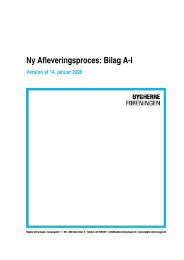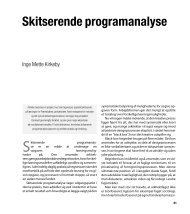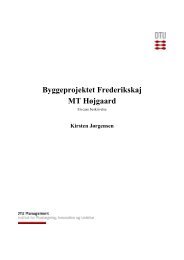Udvælgelses- dan og tildelingskriter ske byggesektor ... - RenProces
Udvælgelses- dan og tildelingskriter ske byggesektor ... - RenProces
Udvælgelses- dan og tildelingskriter ske byggesektor ... - RenProces
Create successful ePaper yourself
Turn your PDF publications into a flip-book with our unique Google optimized e-Paper software.
A Diverse Understanding of Value in the Building Industry 187<br />
To ensure a satisfying result of the survey, a lot of effort was put into<br />
optimizing the questionnaire before distribution. Firstly, the questionnaire<br />
was reviewed among colleagues, and the wording of the questions was<br />
carefully considered to avoid any misleading and misunderstanding of<br />
questions. It should be mentioned that the questionnaire was originally<br />
written in Danish, and afterwards translated into English for academic use.<br />
Secondly, the questionnaire was pre-tested on four selected respondents,<br />
who were later telephone interviewed in order to bring about any<br />
misunderstandings.<br />
The population was theoretically all practitioners in the Danish<br />
building industry. When choosing the sample, the aim was to have between<br />
25-30 respondents in each of the six groups of company types, resulting in<br />
a total sample of approximately 150. The sample was randomly chosen<br />
from industry databases (Bygherreforeningen 2005; Danskbyggeri 2005;<br />
FRI 2005; PAR 2005) and from yellow pages. Semi-personalized cover<br />
letters were made in the survey pr<strong>og</strong>ram (PHPSurveyor 2005), and the<br />
survey webpage was created. The survey was carried out anonymously<br />
through the use of tokens.<br />
1.4.2 Data Analysis and Results<br />
The analysis was carried out in two main steps (Forza 2002). Firstly, a<br />
preliminary analysis was carried out. The purpose was to validate the<br />
sample in terms of internal coherence and in terms of how well the sample<br />
mirrors the population.<br />
After the preliminary analysis, hypothesis testing was carried out. In<br />
this paper some general traits from the collected data is reported. The<br />
method is to combine the Likert scale questions with the dem<strong>og</strong>raphic data.<br />
The data was analysed by using (SPSS 2006). Primarily, a bivariable<br />
correlation analysis test such as spearman’s rho is applied. Furthermore,<br />
ratings from the Likert scales have been divided accordingly to the<br />
dem<strong>og</strong>raphic data. It should be mentioned that data from the Likert<br />
questions has been treated as belonging to an interval scale. The reason<br />
for treating Likert data as an interval scale and not as an ordinal scale is<br />
that a high number of the answers are <strong>ske</strong>w on a normality graph. The<br />
correct way to analyse ordinal data is to look at, e.g. mode. In this survey,<br />
when analysing the mode of different data set grouped according to<br />
different dem<strong>og</strong>raphic data, the mode is often the same. It would have<br />
been appropriate to increase the Likert scale to contain, e.g. 7 categories.<br />
Anyway, focus will now be on the preliminary analysis. The respond<br />
rate can be an indication of how well the survey has been designed and an<br />
indication of the relevance of the research question in mind. The response<br />
rate, R, is calculated to 46% according to equation (1.1) (de Vaus 1993 p.<br />
107).<br />
Nreturned<br />
R = (1.1)<br />
N N<br />
sample<br />
ineligible + unreachable<br />
187










